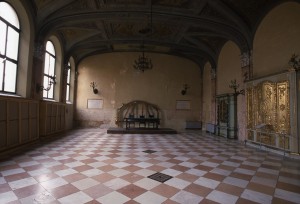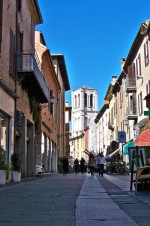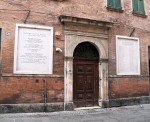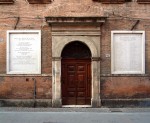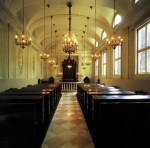The Italian synagogue
The Italian synagogue or Tempio Grande Italiano is the oldest of the three synagogues housed in the Via Mazzini complex. Over the centuries it has undergone various expansions and ceased to be used for worship after the devastation suffered during the Second World War. Giorgio Bassani mentions it in his “Garden of the Finzi Contini”.
1. XV e XVI secolo
The first act that recognizes the oratory of Via dei Sabbioni (Via Mazzini) as the synagogue of all the Jews of Ferrara, thus differentiating it from the washrooms and family oratories, was found in a document of the Office of the Inquisition of 1457. At the time of Ser Mele's bequeathing of the complex in Via dei Sabbioni to the Jewish community of Ferrara, in 1485, the synagogue was located in a small classroom on the second floor and occupied the western portion of the hall of the current Italian Temple.
In the sixteenth century the synagogue of Ser Mele became too small and in 1577 the community requested and obtained permission to begin the expansion and embellishment works: the classroom thus assumed its current size of about 163 square metres.
2. From Emancipation to World War II
New changes took place with the demolition of the gates of the Ghetto, to celebrate emancipation with a modernization of the synagogue: between 1865 and 1867 the coffered ceiling was eliminated, replaced with the sail ceiling still visible today, five large windows were opened and the matroneo on the southern wall was renovated. The most obvious transformation of the hall is the approach of bimah (the tribune from which the Torah is read) and aron (cabinet where the Torah scrolls are kept) in a single area delimited by a marble balustrade, today in the German Synagogue.
After five centuries, the Italian Temple ceased to function as a place of worship in 1944. In September of that year, all the Jews captured in Ferrara in the last great raid of February were locked up in the Italian synagogue, in all 55 among the elderly, women and children, then deported to Fossoli and from here to Auschwitz. Shortly after, the classroom was looted and destroyed by the Nazi-Fascists. The only ceremony held since then is in memory of the victims of persecution on the days of Kippur (Day of Atonement) in 1945.
3.The post-war period
Between 1952 and 1957 the hall was furnished with three aronot (plural of aron): one reconstructs some panels of the Italian aron, while the other two come from the Spanish synagogue in Via della Vittoria, also destroyed during the Second World War. In addition, there are some wooden furnishings of the Rabbinical Court. In the 1990s, thanks also to state funding, new restoration works were undertaken and in 1993 a plaque was placed in the atrium in memory of the people locked up here in 1944, solemnly inaugurated by Giovanni Spadolini.
4. The building today
The former Italian Temple is now a large rectangular hall, mostly used as a conference room. In addition, every year it hosts a hundred people for the celebration of the Passover Seder (the Passover dinner).
On the walls, some tombstones recall important figures of the Jewish community of Ferrara, including Ser Mele and Isaac Lampronti, a doctor and rabbi who lived in Ferrara in the seventeenth century.
5. Quotes
"When we met at the door of the Temple, usually at dusk, after the laborious pleasantries exchanged in the gloom of the porch, we almost always ended up climbing in groups also the steep stairs that led to the second floor, where wide, crowded with mixed people, echoing with organ sounds and songs like a church – and so high, on the roofs, that on certain evenings in May, with the side windows wide open from the side of the sun at sunset, at a certain point we were immersed in a kind of golden fog – there was the Italian synagogue".
Giorgio Bassani, “The Garden of the Finzi-Continis”, p. 26
Bibliography
- Tedeschi Falco, Annamarcella, Ferrara. Guida alle sinagoghe e al museo, Marsilio, Venezia 2001
- Bassani, Giorgio, Il giardino dei Finzi Contini, Mondadori, Milano 2001
- Luoghi ebraici in Emilia Romagna, Touring Club Italiano, Milano-Bologna 2006
- Provasi, Matteo, Ferrara ebraica, 2G Editrice, Ferrara 2010
- Ravenna, Paolo, La sinagoga dei Sabbioni. Il Tempio di Rito Italiano a Ferrara da Ser Mele ai Finzi Contini, Edisai, Ferrara 2012
- Bonilauri, Franco - Maugeri, Vincenza, Sinagoghe in Italia. Guida ai luoghi di culto e della tradizione ebraica, Mattioli 1885, Fidenza (Parma) 2014
Related places
Compiling entity
- Istituto di Storia Contemporanea di Ferrara
Author
- Federica Pezzoli
- Sharon Reichel

